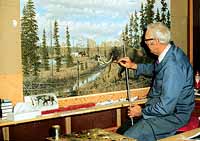
 |
||
 |
||
 |
|
An exhibit artist works closely with scientists, such as curators of natural history, to create murals, dioramas, and other background paintings that are both scientifically accurate and artistically pleasing. The function of the murals is to teach natural history to the public. The artist works with the exhibit designer and technician to make sure the painting can be incorporated well into the structure of the exhibit. Robert
G. Larson Robert Larson started working as an exhibit artist for the Illinois State Museum in 1962 and after retiring in 1987, continues to paint murals for the Museum today. He began the first mural about the Ice Age in Illinois in 1977. Today he is working to complete a total of six large paintings. The first was the Midwestern United States 16,000. Five smaller ones are in production. The
Murals
Two others will be:
These scenes have to be reconstructed from geological and biological evidence found in those areas. Mr. Larson collaborates with the curators of palynology and paleontology. Those scientists will decide what animals and vegetation are appropriate for the place and the time of each scene. Mr. Larson will study plant, animal, and rock specimens in the Museum's collection. He will also go to the sites in various parts of the state and make sketches and take photographs of how the areas look today. The basic landforms will be similar to the ones in the areas during the Ice Age. He will use the facts and details of the scientists' information as a basis for a detailed and accurate painting. The ability of the artist to also create a pleasing composition with good design elements of color, shape, perspective, and value is what turns the finished mural into a work of art. Characteristics
of a Good The ability to work as a team is very important in this career. The artist is not making paintings for himself or herself alone, but for an audience of museum visitors who are learning about natural history.
|
|
|
Copyright© 2000 Illinois State Museum Society
